Huong Pagoda is one of the most well-known historical and spiritual tourist sites, attracting visitors from all over the world, particularly during the yearly festival. In this post, our organization will share some information you may learn more about.
1. Where is Huong Pagoda?
Huong Pagoda (also known as Huong Son Pagoda and Huong Tich Pagoda) is a Buddhist temple on the banks of the Day River in Hanoi’s Huong Son commune, My Duc district.
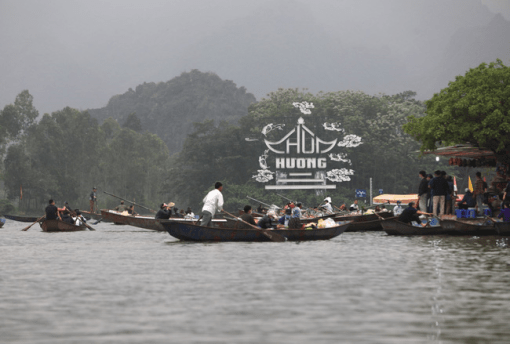
Huong Pagoda is the popular name for a cultural and religious complex that includes hundreds of Buddhist temples and other important temples such as Thien Tru, Giai Oan, Trinh Temple,… The Huong Pagoda, located in Huong Tich Cave, also known as the Trong Pagoda, serves as the population’s hub.
2. The history of Huong Pagoda
2.1.Huong Pagoda’s story
The Huong Pagoda is related to the traditional concept of worshiping the Third Queen. According to mythology, in this region of “Lingshan bliss,” there is princess Dieu Thien, also known as The Third Lord, who is the incarnation of the Bodhisattva Quan Yin, who has been training for 9 years. On the 19th lunar month of the Buddha, she became a Buddha who traveled to help sentient beings.
Lord Jingding Wang Zhengyuan visited Son Nam Town and Huong Tich Cave in March 1770 to burn incense and admire the beauty.
The five words “Southern Heavenly First Cave” were also carved into the cliff outside the cave entryway by God. Lord Trinh Tram is credited with transforming Huong Tich Cave into a renowned landmark and laying the groundwork for the eventual creation of the Huong Pagoda Festival. Every spring since Lord Trinh Tram first stepped foot in Huong Tich Cave, tourists from the surrounding countryside have come to give incense, visit, appreciate the poetry beauty and love.
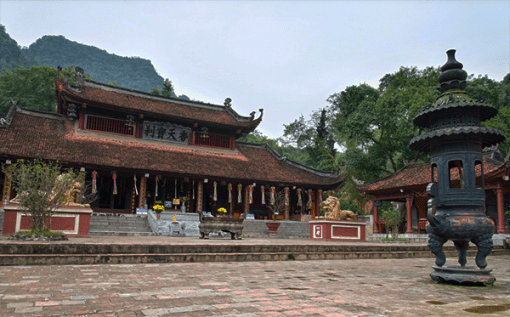
Previously, the Huong Pagoda Festival was held on January 6th, following the Yen Vi village painting festival. Every year on January 6, the Huong Pagoda Festival is still celebrated.
2.2. The history of Huong Pagoda
The temple was erected on a grand scale at the end of the 17th century before being destroyed during the French resistance in 1947. Venerable Thich Vien Thanh, under the supervision of the late Venerable Thich Thanh Chan, renovated the temple in 1988.
2.3. Who does the temple worship?
Who is the Huong Pagoda dedicated to? This is a common question among visitors to the picturesque place.
At Year 2, a green stone figure of Guan Yin was erected in Huong Tich cave (1793).
Trinh Huong Temple, dedicated to the God general Sima Hung Lang, who was vital in defeating the adversary of the 6th Hung King.
Cua Vong Temple (or Van Song Temple) honors the woodland goddess Thuong Ngan Van Huong, also known as Princess Le Mai or the Holy Mother.
The Thien Tru Pagoda (or Tro Pagoda), also known as Ngoai Pagoda, is a massive monastery where Buddhist monks store Buddhist sutras, laws, and treatises.
The five tigers and the deity fish are worshiped in the Bac Dai Pagoda, Tuyet Son Pagoda, Ca Pagoda, and Quan Temple.
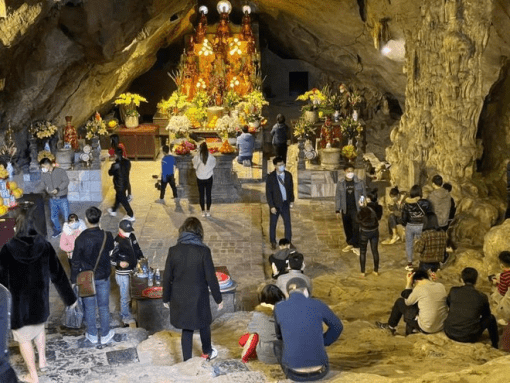
3. What does the population of the Temple of Huong consist of?
Visitors who wish to visit Huong Pagoda can do so via a variety of routes. The major route departs at Duc Wharf on the banks of the Day River. It serves as the entrance to the gorgeous region of Huong Pagoda. You may stop along the route at the Trinh temple on Ngu Nhac hill. It is the mountain god’s temple.

Walking from Tro wharf to Tro pagoda (or Thien Tru, Ngoai), you will notice that the temple’s driveway and courtyard have just been renovated. In the center of Thien Tru’s Buddhist temple is a stone figure of Nam Hai Guan Yin, sculpted after the model in Huong Tich Pagoda but expanded 2.5 times and 2.8m high.
Co Tien Mountain is located near Thien Tru Pagoda, and Tien Pagoda is located within the cave. The shrine has five stone sculptures based on the tale of the Three Noble Ladies. The Third Lady statue stands in the center, flanked by the statues of the eldest sister, Dieu Thanh, riding the blue lion, and the sister of the two Magic Yin, riding the white elephant. The statues of the mother, queen of the third woman, and the father, king, may be seen in the background.
Giai Oan is located between Thien Tru Pagoda and Huong Tich Cave. Long Tuyen is the name of a clear well. The ripe stream is directly in front of the temple. The Giai Oan Stream is its name.
Follow the twisting mountain route for roughly 2 kilometers from Thien Tru Pagoda to Huong Tich Cave (Trong Pagoda). In addition, there is a path that leads from Thien Tru Pagoda through the dream forest to Hinh Bong Pagoda.
4. Take notes while you explore Huong Pagoda
4.1. Travel time
- Visitors to Huong Pagoda frequently pick the lunar calendar months of January to March, since the maximum height is between January 15th to February 15th.
- Visitors can come to the pagoda all year round to observe the rice flowers bloom from March to April, or downstream in the water lily season at Yen Stream bloom from October to November, in addition to the spring celebrations.
4.2. How to go
Visitors may go to Huong Pagoda from Hanoi in a variety of methods, including passenger vehicles, motorbikes, personal automobiles, limos, passenger cars, and so on. If riding my motorcycle, use the Nguyen Trai-Ha Dong road, passing via Ba La, Van Dinh, and Jin Xiao and asking for the way to Huong Pagoda from Chisel wharf. If you’re driving, take National Highway 1A Phap Van–Gie Bridge to the Dong Van crossing, then turn right onto National Highway 38 and go 15 kilometers to Dau Market.
4.3. Clothing
- Sacrifices should wear polite outfits and dress nicely while visiting worship facilities such as temples, temples, communes, monuments, cultural treasures, and so on, especially when going to the temple to present incense. Check the weather forecast as well to ensure that you are dressed adequately.
- The sights and ceremonies of Huong Pagoda need a lot of walking, so a pair of sneakers or shoes will keep your feet comfy.
- Visitors to busy venues in Hanoi, where the incidence of diseases continues to rise daily, should bring masks, drop shields, and hand sanitizer.
4.4. Pilgrimage sites at Huong Pagoda
- The major path is Huong Tich pagoda: Trinh Temple-Thien Tru Pagoda-Tien Son Cave-Giai Oan Pagoda-Tran Song Temple-Huong Tich Cave-Hinh Bong Pagoda.
Thanh Son Pagoda–Huong Dai Cave–Van Dong Long Van Pagoda–Cay Khe Pagoda are the paths from Thanh Son to Huong Dai.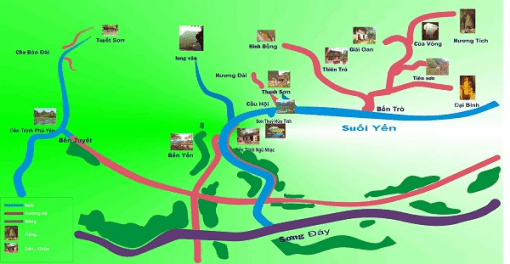 During that day, you can return to Hanoi via the Huong Tich path. There are two extra paths that guests should explore the next day if they have adequate time.
During that day, you can return to Hanoi via the Huong Tich path. There are two extra paths that guests should explore the next day if they have adequate time.
4.5.Ticket price
The main route costs 50,000 VND per person, the secondary route 35,000 VND per person, and scenic tickets cost 80,000 VND per person. You may rent a large boat for 15-20 people to sit together if you travel in a large company, which is more convenient. Furthermore, to prevent crowded circumstances, you may phone ahead to book the boat before the day and time.
For this year’s Huong Pagoda Festival, the price of cable car tickets remains constant. Adults pay VND 180,000 and children to pay VND 120,000 for a round-trip ticket. The adult cost is VND 120,000, while the kid fare is VND 90,000.

4.6.Considerations when buying specialties and souvenirs
Inside the Huong Son Vestige, businesses are offering unusual cuisine and gifts on both sides of the road leading to the temple, the temple, the cave… Especially during festivals, it is vital to inquire about costs and verify the expiration dates of packaged and canned goods before purchasing.
By attending ceremonies, you may avoid buying wild animal goods, prohibiting animals, and limiting the killing or eating of wild animals.
5. Why should we visit Huong Pagoda in Ha Noi City?
Huong Pagoda is the well-known name of a huge religious and cultural complex in our country’s northwestern region. Essentially, this site is more than a pagoda; it is a vast complex with several temples and shrines, as well as secret holy caves.
It is a meeting area for people, erected in the 17th century in Huong Son town, My Duc district, Hanoi. The trees provide shade, and the water runs all year.
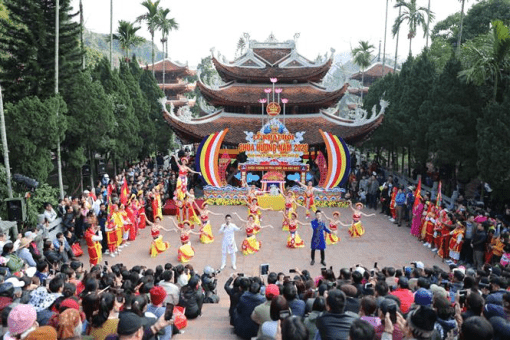
Huong Pagoda is well known for its annual Huong Pagoda Festival, which takes place every year in Hanoi. Thousands of people traveled from all over the world to rejoice, worship, celebrate, offer incense, arrange sports festivals, and engage in extraordinarily lively arts during this time. Even now, a fascinating culture exists.
6. Conclusion
Hopefully, everything we’ve shared thus far has helped you learn more about Huong Pagoda, as well as where Perfume Pagoda is located and what else this temple has to offer. Thank you for your interest in our Huong Pagoda post.
More: Tay Nguyen’s Cong Chieng cultural space: The intangible beauty of Tay Nguyen’s mountains and forests




Bài viết liên quan: